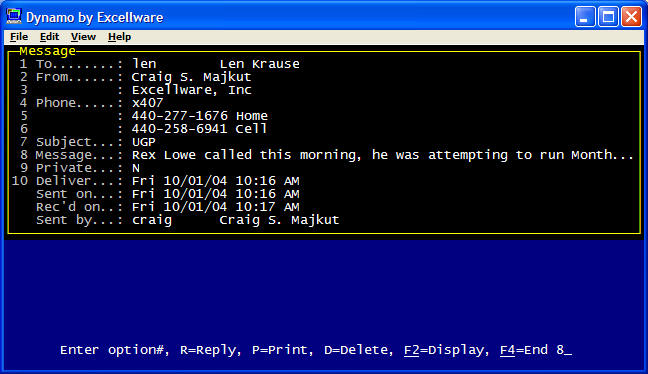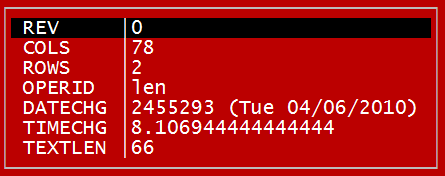|
Return Window/Notepad Text |
Last Revised: 11/16/16 |
This routine is used to return information about window based text created with the W type option of the input routine CDS069. It is typically used when you need to display the first part of the window text, or to determine how many lines the text will require when printed to a printer. This routine is also used to convert window text to html format for emailing or displaying on a web page, or to convert to the format used for entry on a web page within <textarea> tags. Window text is often called a Notepad by application software.
Related programs:
CDS069 - used to display or maintain window text.
CDS257 - used to print window text to a printer, or to write back modified text to the text file.
CDS554 - used to print window text within a grid.
Calling Format:
CALL "CDS261", Y$, FILCHAN$,
TEXTID$, TEXT$, {
LINES, FULL$, HTML$, HTMLFONT,
TEXTAREA$, S261$}
| CDS261 | ||||||||||||||||||
|---|---|---|---|---|---|---|---|---|---|---|---|---|---|---|---|---|---|---|
FILCHAN$
|
In | Can be a channel number of the text file already opened, or the file name where the text is stored. When the file name is passed, CDS261 will open the file using the U option of CDS095, and not close it. | ||||||||||||||||
TEXTID$
|
In | The Text ID such as the customer#, vendor#, item#, or other identification of the window text. | ||||||||||||||||
TEXT$
|
Out |
String up to 80 characters long containing the first part of the window text.
TEXT$ will not contain any attributes such as underlined, bold, etc. White space within the text are stripped out of
TEXT$ with the intent to return the maximum amount of information in
TEXT$. No error is returned if there is no text on file.
TEXT$ will be null in that case.
TEXT$ is typically displayed to the right of some field# or description
letting the operator know that there is some text on file. |
||||||||||||||||
LINES
|
Out | The number of display lines of text in the entire message. Returned as zero if there is no notepad text on file. | ||||||||||||||||
FULL$
|
Out | Contains the entire text, including imbedded line feeds and attribute
mnemonics. Since it can be quite large, you suppress this logic by excluding
FULL$ on the CALL. FULL$ may be needed when an application program needs to append some text onto the end of the stored text. The application program could also manipulate the contents of
FULL$ prior to writing the text back. Use
CDS257 with the
STS$="W" to write window text back to the disc, after modification by the application program.
Use CDS257 with STS$="T" to return
text without line feeds and mnemonics. |
||||||||||||||||
HTML$
|
Out | Contains the entire text formatted in html. The notepad text is
rendered in a fixed point font of Lucida Console, Arial Monospaced,
Courier New, or Courier if HTMLFONT parameter is not
included on CALL or passed with a value of zero.
|
||||||||||||||||
HTMLFONT
|
In | Optionally pass as 1 to exclude paragraph tags in HTML$
that specify a fixed width font. |
||||||||||||||||
TEXTAREA$
|
Out | Contains the entire text in a format suitable for Dynaweb entry within
<textarea> tags. Note that textarea does not support
any attributes such as bold, underlined, reverse video, etc., but it can
be used for plain text including line breaks. |
||||||||||||||||
S261$
|
Out | Contains the following text heading fields
|
||||||||||||||||
| CDS261 is used in the example below to retrieve the first part of the message. It is displayed to the right of field#8 Message, and is stripped of all special attributes such as underlining, bold, blink, etc. |
CALL "CDS261",Y$,STR(SM21),TEXTID$,TEXT$
|

| Example for Dynaweb Application This example retrieves existing Notepad Text from a file named TEXTFILE$ with Notepad ID of TEXTID$ and then sets the
text as the default entry on the web page. |
CALL "CDS261",Y$,TEXTFILE$,TEXTID$,"",0,"","",0,NOTEPAD$
|
Example of S261$ fields available |
CALL "CDS261", Y$, "CDDD13" ,PAD("DD00",10)+"BBJPREFIX", TEXT$, LINES, FULL$, HTML$, HTMLFONT, TEXTAREA$, S261$
|

|
